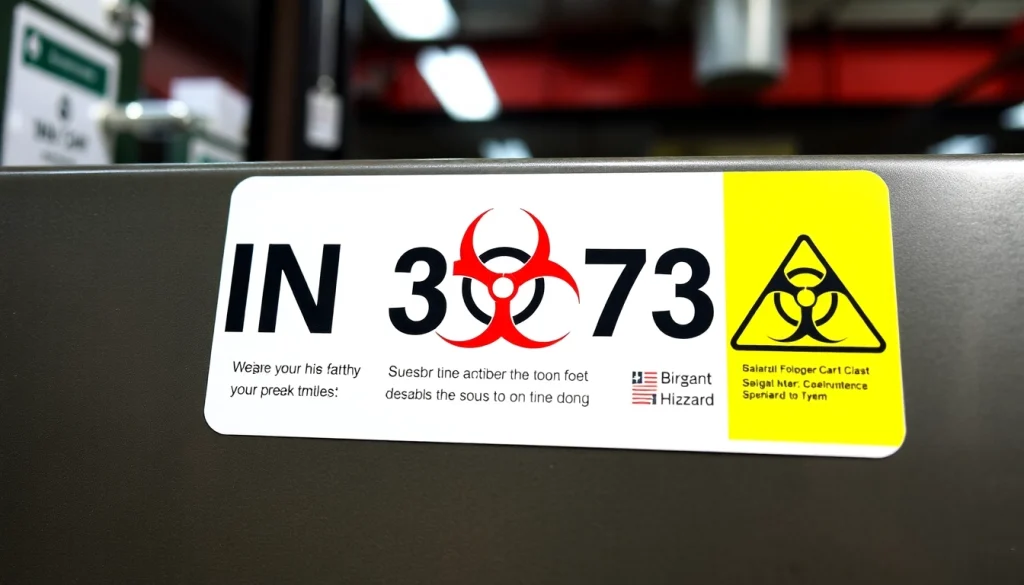Understanding UN 3373 Labels
What is a UN 3373 Label?
The UN 3373 label is a specialized marking used for the transport of biological materials categorized as Category B infectious substances. These substances, which include human or animal samples designated for diagnostic, research, or investigative purposes, must be labeled appropriately to comply with regulatory requirements. The classification of UN 3373 specifies that these materials are not likely to cause severe disease in humans or animals. Thus, while they are treated with caution, they pose a significantly lower risk than their Category A counterparts, which include highly infectious substances requiring more stringent handling protocols.
UN 3373 label is essential in ensuring that these materials are handled and transported with the appropriate degree of safety, as outlined by international guidelines, particularly those of the International Air Transport Association (IATA) and the U.S. Department of Transportation (DOT).
Importance of Proper Labeling
Proper labeling of biological substances is crucial for several reasons. First and foremost, it ensures compliance with international regulations, which is critical for online and offline shipping. Organizations involved in transporting samples must be aware that improper labeling can lead to delays, fines, or even prosecution. Properly labeled shipments facilitate smooth transit through various transport hubs, allowing handlers to swiftly identify and manage potentially hazardous materials.
Secondly, correct labeling serves to protect public health and safety. By identifying materials that may contain pathogens, handlers and emergency responders can take the necessary precautions to mitigate risks. Labels inform individuals about the nature of the contents, allowing them to follow appropriate safety protocols during handling and disposal.
Types of Biological Substances
Biological substances can be classified into different categories as defined by regulations such as those from the World Health Organization (WHO) and IATA. UN 3373 relates specifically to Category B biological substances, which include:
- Human or animal blood and its components
- Human or animal tissues (including organs)
- Culture specimens, including microorganisms
- Body fluids
- Any material suspected of containing infectious agents
Unlike Category A substances, for which the risk of severe disease is high, Category B substances pose lower risks. However, they still require specific handling and transport protocols to ensure safety and compliance with regulatory standards.
Regulatory Requirements for UN 3373
Global Regulations Overview
Several global regulations govern the transportation of biological substances, with critical guidelines established by IATA, DOT, and the United Nations Committee of Experts on the Transport of Dangerous Goods. IATA’s Dangerous Goods Regulations (DGR) provide a framework for the safe transport of substances by air, while DOT regulates the transportation of hazardous materials by land and within the United States.
Compliance with these regulations is paramount for any entity involved in the shipping of biological samples. These bodies require specific labeling, packaging standards, and documentation to accompany shipments of biological materials. Understanding and adhering to these regulations ensures not only legal compliance but also contributes to public safety and confidence in biological material transport.
Compliance with IATA and DOT
Compliance with IATA and DOT involves following specific protocols outlined in their respective regulations. For UN 3373 labels, entities must ensure that:
- Labels are printed appropriately with the correct wording (“UN 3373 Biological Substance, Category B”)
- Labels demonstrate the appropriate orientation on packages (e.g., upright positioning)
- Packages meet prescribed packaging requirements to prevent leaks or contamination
Documents and declarations must accompany shipments, indicating the nature and contents of the biological substance. By following these regulations, organizations can effectively minimize the risk of shipping accidents and comply with global transportation standards.
Common Pitfalls in Labeling
A common pitfall in the labeling of UN 3373 materials is the failure to adhere strictly to the regulatory requirements. This can result from misconceptions or lack of understanding of the regulations. Some frequent errors include:
- Using incorrect labels that do not conform to the IATA or DOT specifications.
- Improper placement of labels, which can hinder visibility and compliance checks.
- Neglecting to update labels based on recent changes in regulations or classification.
Organizations should establish clear protocols for reviewing and updating their labeling practices regularly. This can involve training for staff on current industry standards and the development of checklists to ensure compliance prior to shipment.
Printing and Materials for UN 3373 Labels
Choosing the Right Label Material
Selecting the appropriate material for UN 3373 labels is essential for ensuring their durability and effectiveness during transport. Labels should exhibit properties that allow them to withstand various environmental conditions that they may encounter during shipping. Common materials include:
- Vinyl: Known for its water resistance and durability, vinyl is an excellent choice for labels that will be exposed to moisture.
- PVC: This material offers similar benefits to vinyl, providing strength and resistance to tearing.
- Polyester: Preferred for its ability to endure high temperatures and abrasions, polyester labels can maintain print quality over time.
The choice of material also affects the printing method, longevity, and visibility under various conditions. Organizations must therefore consider their specific shipping conditions when choosing labeling materials.
Recommended Printing Techniques
The printing technique used for UN 3373 labels must ensure high visibility and durability. Recommended methods include:
- Thermal Transfer Printing: This technique uses a thermal transfer ribbon to produce high-quality prints. It provides durability and resistance to smudging.
- Inkjet Printing: While often used for lower volume printing, inkjet can provide vivid colors and high detail. However, the inks used must be resistant to smearing and fading.
- Laser Printing: Known for high-resolution output, laser printing is also suitable for creating durable labels that can withstand various conditions.
Ultimately, the choice of printing should align with the intended use and environmental conditions of the shipping process.
Label Size and Dimensions
The size and dimensions of UN 3373 labels must conform to stipulated regulations while also ensuring they are easily visible and readable. Common dimensions include:
- 1⅜” x ⅜” – Often used for smaller packages.
- 3″ x 4″ – Suitable for standard shipping parcels.
- 4″ x 4¾” – Provides more space for labels with additional information.
Labels should be large enough to accommodate all necessary information without compromising legibility. Adequate contrast between the text and background also aids visibility in transport.
Best Practices for Shipping with UN 3373 Labels
Packaging Guidelines
Proper packaging is integral to the safe transport of UN 3373 labeled materials. Best practices include:
- Utilizing double packaging, where the primary container is enclosed within a secondary outer package that is sturdy enough to withstand transit.
- Ensuring the primary container is leak-proof to prevent any contamination or loss of containment.
- Including absorbent materials within the packaging to contain any potential leaks.
Following these packaging guidelines minimizes the risk of spillage and contamination, ensuring safe delivery and regulatory compliance.
Label Placement on Shipments
The placement of UN 3373 labels is crucial to ensure visibility and compliance. Proper label placement may involve:
- Positioning the label on the topmost side of the package where it is easily visible.
- Ensuring the label does not obstruct other required information.
- Applying the label firmly to avoid peeling or damage during transit.
Consistent label placement according to industry standards contributes to effective communication of the contents and the precautions needed during handling and transport.
Tips for Minimizing Shipping Delays
To minimize shipping delays when transporting biological materials, consider the following best practices:
- Double-check compliance with regulatory documentation, ensuring all required paperwork accompanies shipments.
- Ensure packaging and labeling are completed prior to the shipping deadline.
- Maintain clear communication with logistics providers regarding shipment specifics and any changes that may occur.
By proactively addressing these areas, organizations can enhance efficiency and minimize disruptions in the shipping process.
Frequently Asked Questions about UN 3373
Is UN 3373 a Dangerous Good?
Yes, UN 3373 is classified as a dangerous good under the IATA dangerous goods regulations. This classification is due to the potential presence of pathogens in the biological substances that can pose health risks if proper handling procedures are not followed. Therefore, adherence to the regulations surrounding UN 3373 is critical for ensuring safe transport and compliance with legal standards.
What are Category B Biological Substances?
Category B biological substances include materials referred to in UN 3373, which consist of samples that may contain pathogens but are not expected to cause significant harm under normal handling and transport conditions. This category generally encompasses specimens such as clinical specimens, human or animal tissues, and cultures, making them suitable for transportation in diagnostic or research contexts.
Common Misunderstandings about UN 3373 Labels
A frequent misunderstanding regarding UN 3373 labels pertains to their perceived level of risk. Some may believe that because Category B substances are not as hazardous as Category A substances, they require lower standards of care. However, this is a misconception. Proper labeling, packaging, and handling of Category B materials are still critical for safety and legal compliance, preventing accidental exposure or spillage.


